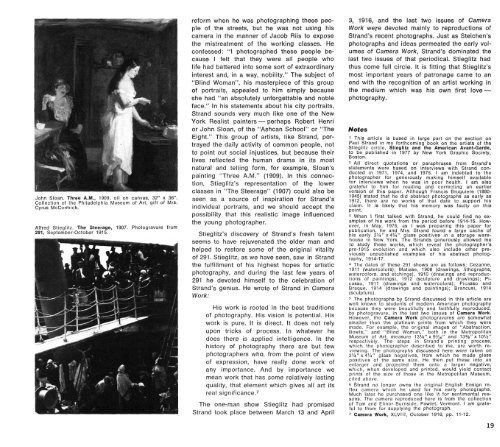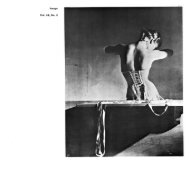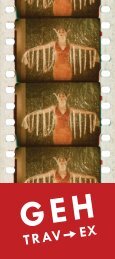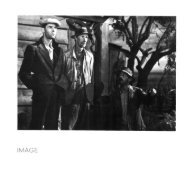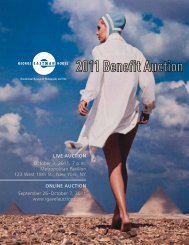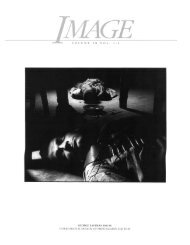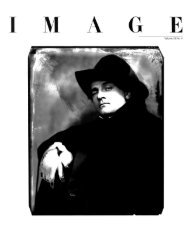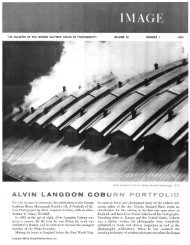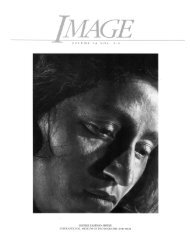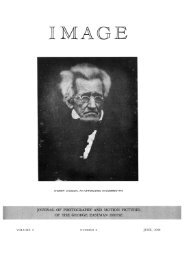Untitled - Issues of Image Magazine - George Eastman House
Untitled - Issues of Image Magazine - George Eastman House
Untitled - Issues of Image Magazine - George Eastman House
Create successful ePaper yourself
Turn your PDF publications into a flip-book with our unique Google optimized e-Paper software.
eform when he was photographing these people<br />
<strong>of</strong> the streets, but he was not using his<br />
camera in the manner <strong>of</strong> Jacob Riis to expose<br />
the mistreatment <strong>of</strong> the working classes. He<br />
confessed: "I photographed these people because<br />
I felt that they were all people who<br />
life had battered into some sort <strong>of</strong> extraordinary<br />
interest and, in a way, nobility." The subject <strong>of</strong><br />
"Blind Woman", his masterpiece <strong>of</strong> this group<br />
<strong>of</strong> portraits, appealed to him simply because<br />
she had "an absolutely unforgettable and noble<br />
face." In his statements about his city portraits,<br />
Strand sounds very much like one <strong>of</strong> the New<br />
York Realist painters — perhaps Robert Henri<br />
or John Sloan, <strong>of</strong> the "Ashcan School" or "The<br />
Eight." This group <strong>of</strong> artists, like Strand, portrayed<br />
the daily activity <strong>of</strong> common people, not<br />
to point out social injustices, but because their<br />
lives reflected the human drama in its most<br />
natural and telling form, for example, Sloan's<br />
painting "Three A.M." (1909). In this connection,<br />
Stieglitz's representation <strong>of</strong> the lower<br />
classes in "The Steerage" (1907) could also be<br />
seen as a source <strong>of</strong> inspiration for Strand's<br />
individual portraits, and we should accept the<br />
possibility that this realistic image influenced<br />
the young photographer.<br />
Stieglitz's discovery <strong>of</strong> Strand's fresh talent<br />
seems to have rejuvenated the older man and<br />
helped to restore some <strong>of</strong> the original vitality<br />
<strong>of</strong> 291. Stieglitz, as we have seen, saw in Strand<br />
the fulfillment <strong>of</strong> his highest hopes for artistic<br />
photography, and during the last few years <strong>of</strong><br />
291 he devoted himself to the celebration <strong>of</strong><br />
Strand's genius. He wrote <strong>of</strong> Strand in Camera<br />
Work:<br />
His work is rooted in the best traditions<br />
<strong>of</strong> photography. His vision is potential. His<br />
work is pure. It is direct. It does not rely<br />
upon tricks <strong>of</strong> process. In whatever he<br />
does there is applied intelligence. In the<br />
history <strong>of</strong> photography there are but few<br />
photographers who, from the point <strong>of</strong> view<br />
<strong>of</strong> expression, have really done work <strong>of</strong><br />
any importance. And by importance we<br />
mean work that has some relatively lasting<br />
quality, that element which gives all art its<br />
real significance. 7<br />
The one-man show Stieglitz had promised<br />
Strand took place between March 13 and April<br />
3, 1916, and the last two issues <strong>of</strong> Camera<br />
Work were devoted mainly to reproductions <strong>of</strong><br />
Strand's recent photographs. Just as Steichen's<br />
photographs and ideas permeated the early volumes<br />
<strong>of</strong> Camera Work, Strand's dominated the<br />
last two issues <strong>of</strong> that periodical. Stieglitz had<br />
thus come full circle. It is fitting that Stieglitz's<br />
most important years <strong>of</strong> patronage came to an<br />
end with the recognition <strong>of</strong> an artist working in<br />
the medium which was his own first love —<br />
photography.<br />
Notes<br />
1 This article is based in large part on the section on<br />
Paul Strand in my forthcoming book on the artists <strong>of</strong> the<br />
Stieglitz circle, Stieglitz and the American Avant-Garde,<br />
to be published in 1977 by New York Graphic Society,<br />
Boston.<br />
2 All direct quotations or paraphrases from Strand's<br />
statements were based on interviews with Strand conducted<br />
in 1971, 1974, and 1975. I am indebted to the<br />
photographer for generously making himself available<br />
for interviews when he was in poor health. I am also<br />
grateful to him for reading and correcting an earlier<br />
version <strong>of</strong> this paper. Although Francis Bruguiere (1880-<br />
1945) stated that he did abstract photographs as early as<br />
1912, there are no works <strong>of</strong> that date to support his<br />
claim. It is likely that his memory was faulty on this<br />
point.<br />
3 When I first talked with Strand, he could find no examples<br />
<strong>of</strong> his work from the period before 1914-15. However,<br />
in May, 1975, as I was preparing this paper for<br />
publication, he and Mrs. Strand found a large cache <strong>of</strong><br />
his early 3Vi" x .4 1 A" glass positives in a storage warehouse<br />
in New York. The Strands generously allowed me<br />
to study these works, which reveal the photographer's<br />
pre-1915 evolution and which also include other previously<br />
unpublished examples <strong>of</strong> his abstract photography,<br />
1914-17.<br />
4 The dates <strong>of</strong> these 291 shows are as follows: Cezanne,<br />
1911 (watercolors); Matisse, 1908 (drawings, lithographs,<br />
watercolors, and etchings), 1910 (drawings and reproductions<br />
<strong>of</strong> paintings), 1912 (sculpture and drawings); Picasso,<br />
1911 (drawings and watercolors); Picasso and<br />
Braque, 1914 (drawings and paintings); Brancusi, 1914<br />
(sculpture).<br />
5 The photographs by Strand discussed in this article are<br />
well known to students <strong>of</strong> modern American photography<br />
because they were beautifully and faithfully reproduced,<br />
by photogravure, in the last two issues <strong>of</strong> Camera Work.<br />
However, the Camera Work photogravures are somewhat<br />
smaller than the platinum prints from which they were<br />
made. For example, the original images <strong>of</strong> "Abstraction,<br />
Bowls," and "Blind Woman," both in the Metropolitan<br />
Museum <strong>of</strong> Art, measure 13V4" x 9 3 A&" and 13 3 /a" x 10V2"<br />
respectively. The steps in Strand's printing process,<br />
which the photographer described to me, are worth reviewing.<br />
The photographs discussed here were taken on<br />
3'/4" x 4 1 /4" glass negatives, from which he made glass<br />
positives <strong>of</strong> the same size. He then put these into an<br />
enlarger and projected them onto a larger negative,<br />
which, when developed and printed, would yield contact<br />
prints <strong>of</strong> the size <strong>of</strong> those in the Metropolitan Museum,<br />
cited above.<br />
6 Strand no longer owns the original English Ensign reflex<br />
camera which he used for his early photographs.<br />
Much later he purchased one like it for sentimental reasons.<br />
The camera reproduced here is from the collection<br />
<strong>of</strong> Tom and Elinor Burnside, Pawlet, Vermont. I am grateful<br />
to them for supplying the photograph.<br />
7 Camera Work, XLVII1, October 1916, pp. 11-12.<br />
19


